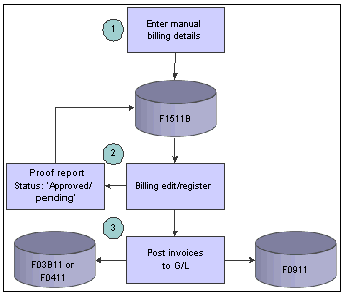Understanding the Manual Billing Process
Use the Manual Billing Entry program (P1511) to generate invoices to bill tenants for one-time charges such as build-outs, supplies, and repairs. You can also use this program to revise billing records that were created manually and ones that were created automatically. Additionally, if the lease is set up appropriately, you can use the P1511 program to generate vouchers for payments.
This table describes the steps in the manual billing process:
Step |
Description |
|---|---|
Enter the manual billings. |
You enter the billing information that you use to process an invoice or voucher. The system creates a batch record in the Batch Control Records table (F0011) and records in the Tenant/Lease Billings Detail Master table (F1511B). (Release 9.2 Update) If you are entering manual billing records for a lessee accounting lease, you can enter billing records for leased property assets by entering a value in the Unit field. The system then populates the Unit Asset Number field with the value from the Unit Master. You can also enter billing records for non-property assets by entering a value in the Asset Number field. You can also specify whether the billing record has an effect on the right of use (ROU) asset. Billing records that impact the ROU asset are included when generating amortization schedules for the associated asset. For a lessee lease, the transaction currency and the exchange rate are derived from the lease header. These fields are disabled in the detail grid and cannot be edited irrespective of how the processing options are defined. |
Revise unposted billing transactions. (optional) |
Use the Manual Billing Entry program (P1511) to revise and delete unposted billing transactions in the F1511B table, regardless of the generation type. |
Generate the Billing Edit/Register report. |
After you enter manual billings, you must run the Billing Edit/Register program (R15300) to validate that the batch is ready to post. (Release 9.2 Update) The R15300 program has been updated to determine if billing records should be included in the revenue recognition process. The program compares the information on the billing transaction to the revenue recognition trigger configuration, and if the record should be included in the revenue recognition process, the system validates that the appropriate AAIs and accounts are set up. |
Review transaction batches. (optional) |
Use the Real Estate Journal Review program (P150011) to review, revise, and delete transactions, such as billings or fees, from a batch If no errors occur when you run the R15300 program, the system changes the batch status to either Pending or Approved, depending on the setting of the Management Approval of Input option in the Accounts Receivable or Accounts Payable constants. If you select the Management Approval of Input option, the system changes the batch status to pending and you must approve batches before posting them. If you do not select the Management Approval of Input option, the system changes the batch status to approved and the batches are ready to post. |
Post invoices and vouchers. |
You can post batches at an Approved status. Depending on the lease, you run the R15199 program to generate either invoices or vouchers. For payable leases, the system creates vouchers with a Supplier Invoice Number (VINV) as a combination of doc type, doc number (for the voucher) and company. (Release 9.2 Update) The R15199 program has been updated to determine if billing records should be included in the revenue recognition process by comparing the information on the billing transaction to the Real Estate trigger configuration. If at least one pay item from the billing invoice is included in revenue recognition processing, the system writes journal entries to the performance liability accounts instead of writing to the billing accounts and creates the corresponding entries for revenue recognition in these tables:
|
Print invoices. (optional) |
You can print and send invoices to tenants after you post invoices. See Printing Invoices. |
Print statements. (optional) |
You can print and send statements to tenants after you post invoices. See Printing Statements. |
Review billing transactions |
You can review manual billing transactions in detail in the Billings Transaction Inquiry program (P15211). |
Review tenant invoice transactions. (optional) |
You can review the invoices that are generated from billing transactions using the Tenant Ledger Inquiry program (P15222). |
Review tenant voucher transactions. (optional) |
You can review the vouchers that are generated from manual billing transactions in the Supplier Ledger Inquiry program (P0411). |
You must run the programs that are designated as required to complete the billing generation process.
This flowchart illustrates the billing process that the system uses and the tables that are updated:
